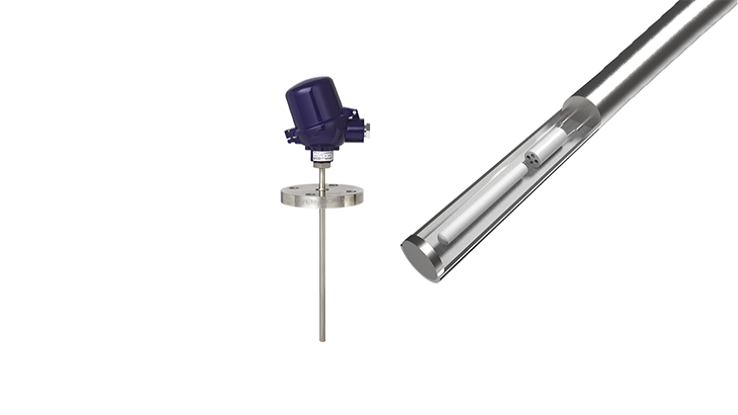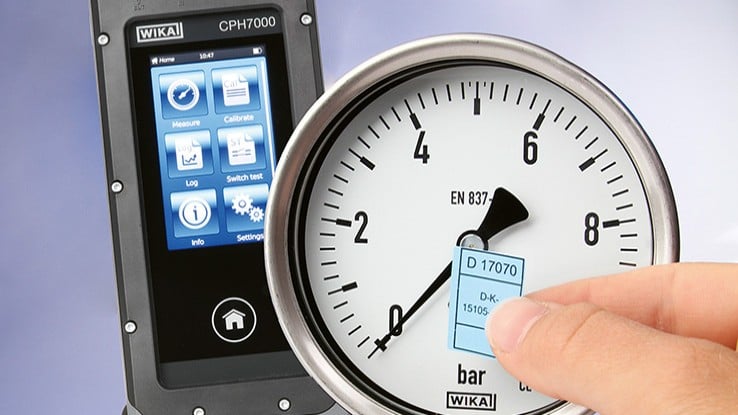Pt100/Pt1000 resistance thermometers by WIKA
The sensor of a resistance thermometer features a temperature-dependent electrical resistance. This increases with the temperature and is therefore known as a PTC (positive temperature coefficient). With industrial measuring requirements, primarily Pt100 or Pt1000 measuring resistors are used. In IEC 60751 (DIN EN 60751), the exact characteristics of these measuring resistors and of the thermometers based on them are defined. For further information on the properties of a Pt100 or Pt1000 temperature sensor, see WIKA technical information IN 00.17.
WIKA can supply all resistance thermometers, either with Pt100 or with Pt1000 temperature sensors:

WIKA online shop
How are Pt100/Pt1000 resistance thermometers constructed?
In industrial use, Pt100/Pt1000 resistance thermometers usually exist as a measuring insert which is installed in a connection head and appropriate protective components. The electrical connection is made within the connection head. The easily replaceable unit of the thermometer is referred to as a measuring insert, which consists of a conduit or cable from suitable material and whose sensitive end contains one or more Pt100/Pt1000 platinum measuring resistors. Protected by a thermowell, a temperature measuring point can be constructed that enables the exchange of the thermometer in the event of repair or calibration without interfering with the process.
A further industrial design of Pt100/Pt1000 resistance thermometers are those known as cable probes. In these cases, the connection cable is assembled directly with the metallic part of the thermometer.
Why Pt1000 instead of Pt100?
Whether a temperature sensor Pt100 or a temperature sensor Pt1000 is used depends on the respective application. In the process industry, Pt100 temperature sensors represent the most frequently used and the most common type of resistance sensor worldwide. However, there are applications where the use of Pt1000 temperature sensors makes sense. Thus, for example, with a two-wire connection, the use of Pt1000 temperature sensors has the advantage over Pt100 temperature sensors, since here the influence of the cable length in the overall measured error is only a fraction of that of Pt100 sensors. Even with battery-powered thermometers, the higher nominal resistance of the Pt1000 temperature sensor has a positive effect on the energy balance of the instrument. For this reason, batteries have a longer service life, meaning longer maintenance intervals and with that reduced service costs. When using Pt1000 temperature sensors, it should be ensured that the downstream evaluation electronics can actually process the Pt1000 signal. In modern temperature controllers or display instruments this is usually the case, as the sensor input can be freely configured.
Why must resistance thermometers be calibrated regularly?
Over the course of time, every measuring instrument will display changing measured values. This is because instruments age through the influence of mechanical, chemical or thermal stresses. Through calibration, this can be detected in good time. It is thus essential to calibrate Pt100/Pt1000 resistance thermometers at regular intervals.
The calibration of temperature measuring instruments is fundamentally different from the procedure for pressure measuring instruments. Often, thermometers are only calibrated at a single fixed point. This could be, for example, the triple point of water. For the calibration of Pt100/Pt1000 temperature sensors, their, usually very well-known, characteristic curve is then shifted downwards or upwards so that the temperature measuring instrument shows the correct value at the fixed point.
Industrial thermometers are usually calibrated with a higher-quality measuring instrument. This is often done with immersion baths or furnaces. As soon as a thermal equilibrium between the Pt100/Pt1000 resistance thermometers and the bath liquid has settled, the display (or the output signal) of the test items is compared with that of the standard thermometer. In particular, this scenario is very popular on-site, where one uses dry-well calibrators.
You can find out more about calibration at WIKA in our service area.
What minimum insertion lengths are recommended, as a rough guide, for protection tubes in order to minimise the heat dissipation error?
- For gaseous media: 15 ... 20 x protection tube diameter
- For liquid media: 5 ... 10 x protection tube diameter
- For solid media: 3 ... 5 x protection tube diameter
(These standard values are only valid for static media. The gap between the protection tu ...
more




